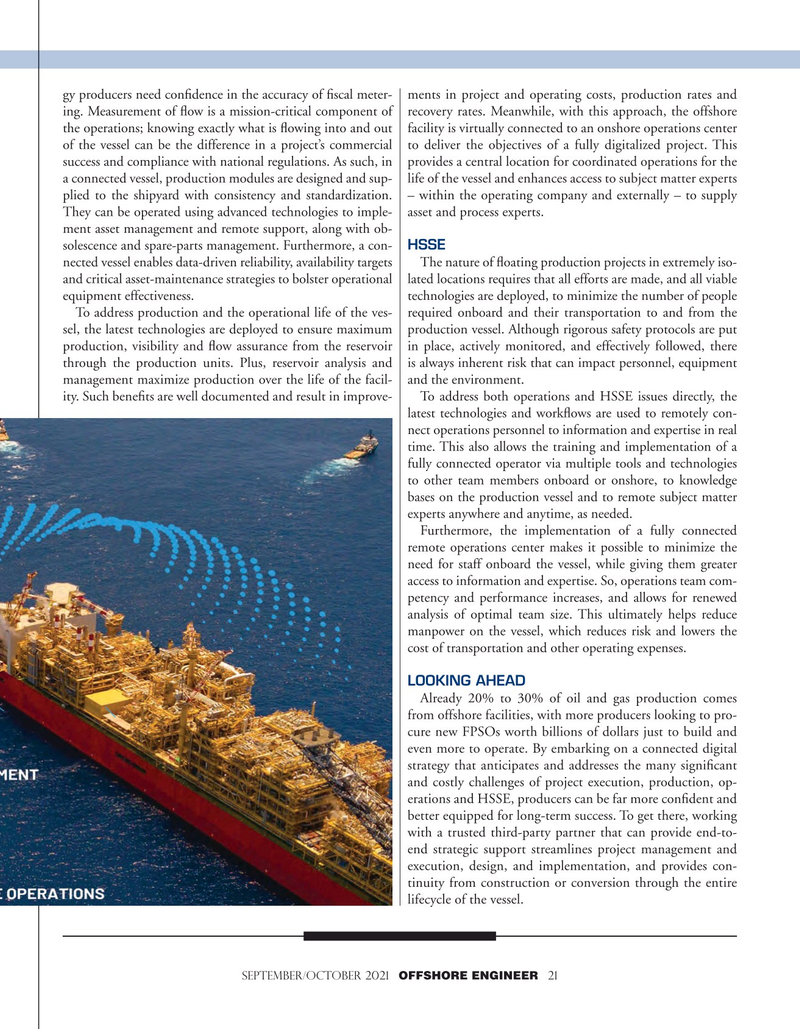
Page 21: of Offshore Engineer Magazine (Sep/Oct 2021)
Digital Transformation
Read this page in Pdf, Flash or Html5 edition of Sep/Oct 2021 Offshore Engineer Magazine
gy producers need confdence in the accuracy of fscal meter- ments in project and operating costs, production rates and ing. Measurement of fow is a mission-critical component of recovery rates. Meanwhile, with this approach, the offshore the operations; knowing exactly what is fowing into and out facility is virtually connected to an onshore operations center of the vessel can be the difference in a project’s commercial to deliver the objectives of a fully digitalized project. This success and compliance with national regulations. As such, in provides a central location for coordinated operations for the a connected vessel, production modules are designed and sup- life of the vessel and enhances access to subject matter experts plied to the shipyard with consistency and standardization. – within the operating company and externally – to supply
They can be operated using advanced technologies to imple- asset and process experts.
ment asset management and remote support, along with ob- solescence and spare-parts management. Furthermore, a con- HSSE nected vessel enables data-driven reliability, availability targets The nature of foating production projects in extremely iso- and critical asset-maintenance strategies to bolster operational lated locations requires that all efforts are made, and all viable equipment effectiveness. technologies are deployed, to minimize the number of people
To address production and the operational life of the ves- required onboard and their transportation to and from the sel, the latest technologies are deployed to ensure maximum production vessel. Although rigorous safety protocols are put production, visibility and fow assurance from the reservoir in place, actively monitored, and effectively followed, there through the production units. Plus, reservoir analysis and is always inherent risk that can impact personnel, equipment management maximize production over the life of the facil- and the environment.
ity. Such benefts are well documented and result in improve- To address both operations and HSSE issues directly, the latest technologies and workfows are used to remotely con- nect operations personnel to information and expertise in real time. This also allows the training and implementation of a fully connected operator via multiple tools and technologies to other team members onboard or onshore, to knowledge bases on the production vessel and to remote subject matter experts anywhere and anytime, as needed.
Furthermore, the implementation of a fully connected remote operations center makes it possible to minimize the need for staff onboard the vessel, while giving them greater access to information and expertise. So, operations team com- petency and performance increases, and allows for renewed analysis of optimal team size. This ultimately helps reduce manpower on the vessel, which reduces risk and lowers the cost of transportation and other operating expenses.
LOOKING AHEAD
Already 20% to 30% of oil and gas production comes from offshore facilities, with more producers looking to pro- cure new FPSOs worth billions of dollars just to build and even more to operate. By embarking on a connected digital strategy that anticipates and addresses the many signifcant and costly challenges of project execution, production, op- erations and HSSE, producers can be far more confdent and better equipped for long-term success. To get there, working with a trusted third-party partner that can provide end-to- end strategic support streamlines project management and execution, design, and implementation, and provides con- tinuity from construction or conversion through the entire lifecycle of the vessel.
september/october 2021 OFFSHORE ENGINEER 21

 20
20

 22
22